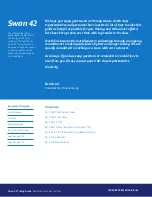
3
Swan 42 Tuning Guide
Solutions for today’s sailors
Part 5: On the water tuning
before starting
Light air from 4 to 9 knots.
• Headstay should be at max length.
• D1 should be loose enough to allow
mast to sag to leeward at the lower
spreader by 15mm.
• Caps or upper shroud should be
loose enough to allow mast to sag to
leeward by 2cm at second spreader.
Note this is a good test of the D2
tension. If D2 is too tight the mast
will not sag evenly on a lateral plane.
• Leeward cap should be tight enough
to be stable but loose enough to be
wiggled slightly by one hand.
This set-up allows the maximum mast
bend with minimum headstay tension
easily absorbing extra the luff curve which
must be in the main for strong winds. This
set-up is excellent when used with the
light or Code 1 headsail.
Theme:
“Induce headstay sag to make the
jib powerful without compromising main
shape”
Medium wind from 8 to 15 knots:
• Headstay should be BASE.
• D1 should be tight enough to set
mast without any lateral sag.
• Caps or upper shroud should be tight
enough to prevent lateral sag.
• Leeward cap should be tight enough to
be stable in a seaway but loose enough
to be wiggled slightly by one hand.
This set-up allows the main to be set
optimally and still have enough headstay
tension to make the medium or Code 2.
headsail to operate in a wide range.
Theme:
“maximum flexibility in sail shape”
Fresh wind from 14 to 20 knots:
• Headstay should be set to 1.715m.
• D1 is adjusted to be tight enough to
ensure a straight mast with perhaps a
slight windward projection.
• Caps are adjusted to be hard enough
to keep mast straight laterally.
Leeward cap can still be wiggled
by one had but is not moving in a
seaway.
• D2 is tight enough to allow the
second spreader have 1-2mm of
windward projection.
Note:
When sighting mast for lateral sag,
do so from behind the mast looking up
the sail track at deck level.
Theme:
“As wind strength builds headstay
tension must also in order to permit sails
to be twisted.”
Strong winds above 23 knots:
• Headstay should be max tight.
• Caps are adjusted to keep slight
tension on the leeward shroud even in
a typical 23 knot seaway.
• D1 is tight enough to bring mast to
windward by 15mm at the bottom
spreader. The leeward side D1 does
not move while sailing upwind.
• D2 is automatically tight enough
to bring the second spreader to
windward by 15mm as well.
• This set-up is great for use with the
ORC #4 Headsail.
Note:
In order to adjust the shroud
tension safely without the use of the mast
jack, it is recommended the turnbuckles
have Lanacote applied and tension the
backstay to maximum before making any
shroud adjustments.
Theme:
“The headstay must be
reasonably tight to permit the sails to be
twisted without over-bending the mast
and without inverting the mainsail.”



























